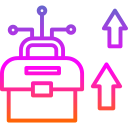Automation and Job Evolution: A Human-Centered Future of Work
From Looms to LLMs: A Short History of Job Evolution
The Jacquard Loom and the First Software of Holes
Early nineteenth‑century weavers used punch cards to guide patterns, a proto-programming moment that unsettled craft guilds yet expanded design possibility. Resistance was real, but so was reinvention: some artisans became pattern designers and workshop owners, blending creativity with mechanized precision.
ATMs, Bank Tellers, and the Sales Shift
When ATMs spread, many predicted teller jobs would disappear. Instead, branches became cheaper to operate and expanded, while tellers shifted into relationship roles, small business advice, and fraud prevention. Tasks changed first; job titles and career ladders evolved more slowly.
Containerization and Dockworkers
Shipping containers reduced manual loading, reshaping port labor from brute strength to logistics coordination, safety, and crane operation. The change was disruptive but also professionalized many roles. Today’s lesson: plan transitions that honor skills, retrain early, and bring workers into decisions.
What Humans Do Best Alongside Machines
Sensemaking and Empathy
When tools surface data, humans find meaning in context, emotion, and values. A nurse calming a worried family or a manager guiding a stressed teammate brings nuance that dashboards miss. Empathy converts information into trust and action.
Creative Problem Framing
Before solving, someone must ask the right question. Framing a messy customer complaint or a stubborn quality defect invites experimentation, metaphor, and reframing. Machines optimize; humans redefine the box, crafting better problems that spark better, safer solutions.
Ethical Judgment and Context
Edge cases are where values appear. Should a recommendation be delayed to protect privacy? Should speed yield to safety? Judgment grounded in lived experience, diverse perspectives, and social norms keeps automation aligned with human outcomes that genuinely matter.
Designing Work with AI Co‑pilots
Task Decomposition and Handovers
Break projects into tasks the co‑pilot can reliably draft, then define crisp handovers back to people for judgment, tone, or compliance. A small accounting firm cut report prep time by half by standardizing prompts, checklists, and review checkpoints.
Human‑in‑the‑Loop Quality
Embed verification, not vibes. Reference sources, run spot checks, and label automated outputs. One marketing team rotates a weekly “red team” to stress‑test AI drafts for bias and claims, boosting accuracy while teaching everyone sharper critical reading habits.
Team Rituals for Safe Adoption
Weekly retros, prompt libraries, and shared failure logs turn isolated experiments into collective intelligence. Celebrate lessons from misfires, not just wins. Socializing practices prevents shadow automation and helps newcomers adopt tools with confidence and accountability.

Swap passive videos for tiny sprints tied to real deliverables: build a data dashboard, automate a spreadsheet, prototype a customer email flow. Immediate relevance cements knowledge and demonstrates value to managers who control stretch opportunities.

Industry Snapshots: Automation in Practice
Manufacturing and Cobots
Collaborative robots handle repetitive assembly and ergonomically risky motions while technicians program, maintain, and improve cells. One plant cut injuries and scrap by pairing cobots with operator suggestions gathered during daily stand‑downs and rapid kaizen workshops.
Healthcare and Decision Support
Clinical AI flags anomalies and suggests differential diagnoses, but clinicians integrate context—patient history, goals, and community realities. A rural clinic improved outcomes by using triage algorithms to prioritize visits while nurses coached patients on realistic self‑care routines.
Media and Automated Drafting
Newsrooms use automation for data‑heavy summaries—local sports recaps, weather alerts, market moves—while journalists investigate, interview, and craft narratives. Editors set source standards and transparency policies so readers know where automation helped and where humans led.
Your Next Step in an Evolving Career
List weekly tasks, then label them as automate, augment, or amplify. Pick one candidate to streamline this week and document the result. Revisit monthly to track time saved and skills gained, turning insights into leverage.
